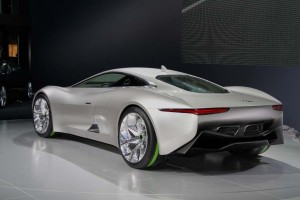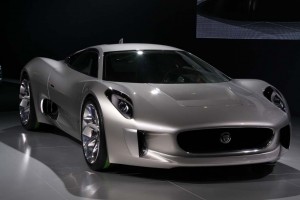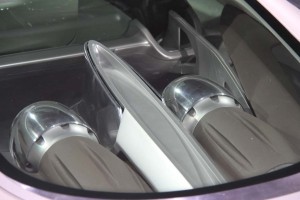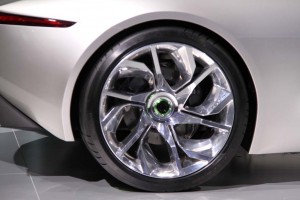We’ve had a chance to get up close and personal with the new Jaguar C-X75, the battery-powered supercar making its surprise debut at the 2010 Paris Motor Show. Here are some more photos and details.
As we earlier reported, the British maker claims the C-X75 will hit 205 mph. That’s a significant number for any automobile, and all the more so when you consider it has a surprising amount in common with the new Chevrolet Volt extended-range hybrid.
(Click Here for our earlier X-C75 story.)First, a few basics, like the fact that the C-X75’s four separate wheel motors produce a combined 770 horsepower and a blistering 1,180 lb-ft of torque, Jaguar claims the striking 2-seater will not only be capable of topping 200 mph, but launching from 0 to 100 kmh (0 to 62.5 mph) in just 3.4 seconds.

Using both batteries and a pair of turbing generators, the C-X75 would be able to go almost 600 miles without a recharge or refill.
Significantly, the sleek prototype — which designer Ian Callum designed to pay tribute to the legendary Jaguar XJ13 supercar — uses not only a pack of lithium-ion batteries, but a pair of super-light micro-turbines to keep going once those batteries have discharged.
Generating 94 horsepower each, they serve as generators, rather than directly driving the wheels. So, much like the Volt, they’ll be used here to provide current for the C-X75’s wheel motors.
That means a range of about 68 miles on batteries but another roughly 500 miles on gasoline.
One of the advantages of using electric drive is that “the physical make-up actually allows us more design freedom,” says Callum. “It becomes more of a work of art.”
For his part, Mike O’Driscoll, Jaguar’s Managing Director, describes the supercar as, “a tribute to the people who shaped the iconic Jaguars that are revered to this day,” adding that, “By making it an innovative test-bed for the technologies of tomorrow, it also ensures that our reputation for engineering excellence will continue for another 75 years and beyond.”
Jaguar is in the midst of a grand redesign, especially after its sale by Ford to the ambitious Indian automaker, Tata. It could certainly use a limited-edition offering like the C-X75, concedes Carl-Peter Forster, the one-time head of Opel now running both Jaguar and its sibling brand Land Rover.
But the company has plenty of other projects going, he glumly acknowledges, “and logic would tell us we can’t squeeze in another production program.” But when pressed whether he’d like to let the heart win out in this debate, Forster smiles and admits he and the rest of the Jaguar team would very much like to find a way to make the C-X75 concept a reality.



